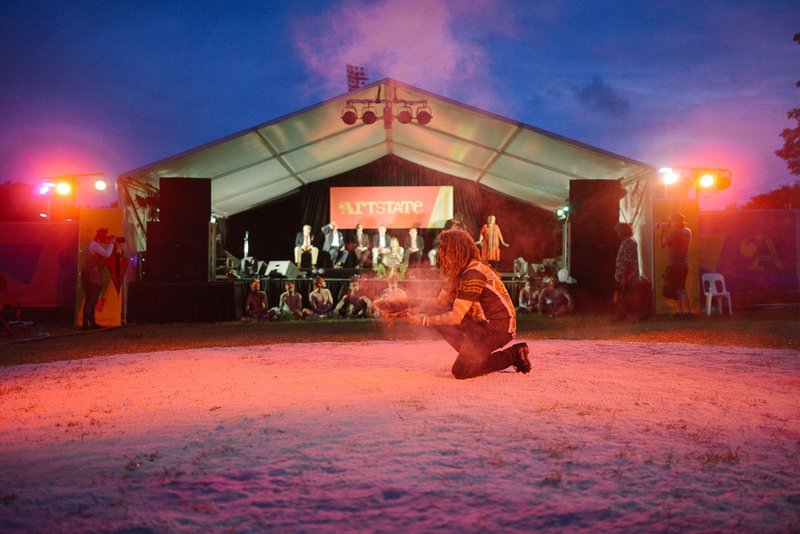Q&A with Elizabeth Rogers
We caught up with Elizabeth Rogers, CEO of Regional Arts NSW about the upcoming Artstate Tamworth, 31 October - 3 November 2019.
We caught up with Elizabeth Rogers, CEO of Regional Arts NSW about the upcoming Artstate Tamworth, 31 October - 3 November 2019.

Artstate Lismore opening ceremony, photo by Katelyn-Jane Dunn, 2017.
Artstate has a clear purpose to demonstrate the value of the arts in regional NSW by developing an ongoing conversation around the themes identified by our rapporteurs from the previous event and through showcasing the best arts practice from the various regions in which Artstate is held. We aim to attract delegates from the metropolitan areas as well as other regions to build a greater understanding of the diversity of landscapes in NSW. Each region has different strengths and an amazing diversity of artists from all genres. The New England North West has a very strong representation of writers for example, and that is reflected in both the speakers program and the arts program. Artstate gives people the opportunity to take time out of their workplaces, share in an inspiring conference program, experience the arts program and connect with old and new colleagues. We deliberately program time for those informal meetings and conversations that can lead to potential new projects and collaborations that occur organically when a group of artists and arts workers meet in a new location over a period of days. As to resetting the NSW agenda, that is yet to be determined.
From the beginning, RANSW was determined that Artstate would integrate both parts of the program with NSW Aboriginal artists and arts leaders. This goal was led in the beginning by Peter White and we continue to be informed and guided by Peter and Sharni Jones at board level. As a nation we need to hear these voices loud and clear. Aboriginal people make up a large proportion of the populations of regional towns. The engagement process commences the year prior to Artstate landing on their Country, meeting with, and listening to local Elders to ensure that they are fully engaged with the event. For Tamworth, we invited the Kamilaroi Elders to attend the Bathurst event to give them a clear understanding of the role we would hope they would play. The Elders then decide what their roles will be. This is an ongoing learning experience and we take lessons learned from the previous event and apply to the current one. We also connect globally with First Nations speakers from regional areas in other parts of the world to share common experiences and solutions. This year we have been able to bring Patrick Shannon, a Canadian Haida artist, storyteller and social entrepreneur.
The reform to the old Arts Council model commenced in 1998 following the 1996 McDonnell review, (long before my appointment!). It was designed to meet the arts and cultural aspirations of regional communities to complement metropolitan touring of exhibitions and performances. McDonell’s summary statement ‘the rapidly growing coastal strip, the number of medium sized inland cities and the far flung rural hinterland present, in turn, a challenge in diversity for which no single response will ever be adequate nor sufficiently comprehensive’. Justin McDonnell, 1996 Review of NSW Arts Council, still holds up today. It was also the beginnings of a statewide engagement with local government to encourage greater investment in arts and cultural development for their local communities. Today local government in regional NSW is the largest provider of cultural infrastructure and the largest employer of professional arts workers. The network of 14 Regional Arts Development Organisations (RADO) is a unique state and local government partnership responding to the diverse needs of their regions. RADOs cover huge areas. The strength of this network is their deep engagement with local artists and arts organisations enabling them to develop projects and programs that respond directly with community aims in the way that would be completely impossible for an organisation based in Sydney. In 2017 the estimated combined mileage for the network was 537,700 kilometres. (It’s only 348,400 kms from Earth to the Moon). It is this ‘on the ground’ approach that is one of the critical elements of the success on the NSW model.
It’s quite simple, invite them to everything you are doing! They may not turn up, but the correspondence will be in their records. The more invitations they get, the greater will be their understanding that there is a vibrant and skilled arts sector in their electorate. So many only engage with their local MPs at election time. If you score a meeting, don’t waste their time. They are not interested in a meet and greet. Have an agenda and a clear understanding of what you want to achieve. If you are an arts organisation, take your chair or a member of your board if at all possible. (On a side note, the proportion of funding allocated in general terms to regional projects is determined on the number of people indicating that they are an artist in the census.)
The overall arts funding pool is an ongoing issue. The value of the arts contributing to cross portfolio outcomes such as the economy, health, environment, natural disaster support as well as creating vibrancy and well-being in in regional communities, is poorly understood and we haven’t been very successful in articulating this. For NSW, the most pressing national issue is the lack of federal investment in Aboriginal arts and cultural development.
Attend Brad Moggridge’s opening keynote at Artstate Tamworth. This Gamilaroi man is also a water scientist and will be talking about looking at our water management practices through the lens of traditional Aboriginal culture. Water is the biggest issue of our day, and especially in the North West of NSW.